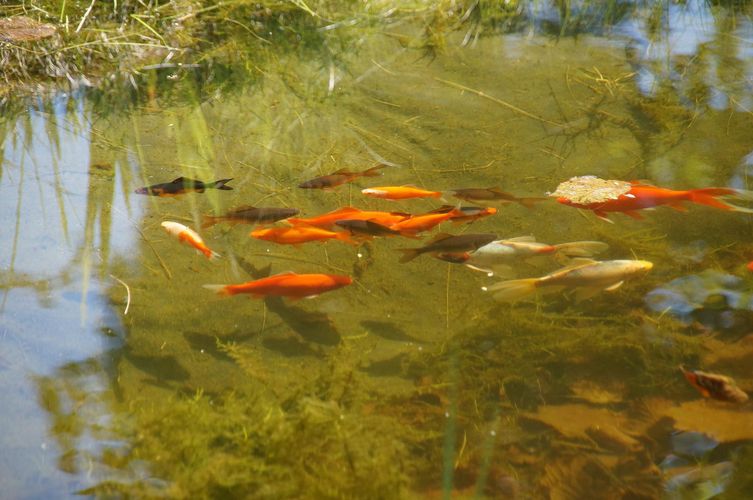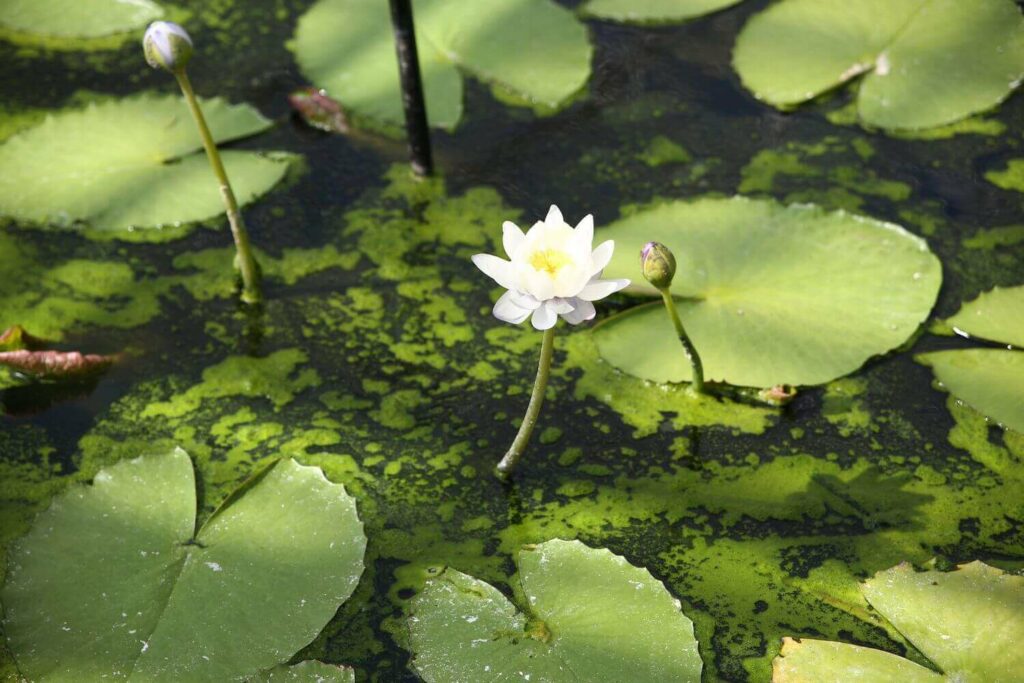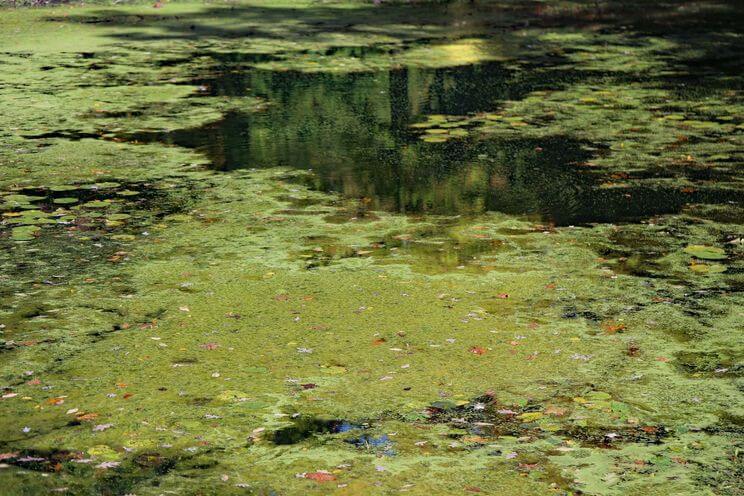Blanket weed, or water silk, is very common in many ponds around the world, especially ponds in cooler climates and with plenty of water movement.
The weed grows wild and can quickly overtake a pond.
It’s important to know how to identify it, what it can do, and ways of removing it.
As we will discuss, in some cases, it can provide benefits, but it also creates many issues for your pond!
What is blanket weed?
Blanketweed is a form of algae; it spreads from spores and clings itself to any and all surfaces within a body of water, including plants, rocks and filters!
Blanketweed is a plant-like organism, it feeds on sunlight, nitrates and other minerals within the water and it is made up of millions of tiny algae cells all growing in unison.
It takes on the appearance of dark green fluffy growth along the surfaces of your pond – it will typically grow more along a current, or place of high flow.
To the touch, it feels like loose rope or hair. The algae is coarse and rough and does not break away easily.
Do goldfish eat blanket weed?
There are a few types of fish that may eat blanket weed, though this isn’t guaranteed. These include:
- Goldfish
- Loach
- Koi
- Pleco
- Siamese Algae Eater
What is pond algae?
There are tens of thousands of described algae species, all belonging to different families and genre; in fact, algae are one of the oldest and most diverse forms of life on earth!
As mentioned, they are made up from millions of individual, microscopic cells, all growing in unison to extract nutrients from the water.
It is hard to find a body of water on earth which does not contain a type of algae, and so it is incredibly likely that a pond will grow algae at some point in its lifespan.
How to tell if you have blanket weed

You will know if you have blanket weed if one of these algaes in your pond appears like dark green hair, or long fluffy growth on plants and rocks. It is very easy to spot, as it grows very large and can quickly swamp a pond!
Blanket weed can grow inside a pump or filter and can clog it!
You may notice that the flow of your filter has reduced or the current has reduced. At this stage, you should open up your filter and take a look, it may just be clogged with blanket weed.
What causes blanket weed in a pond?
Blanket weed is often introduced via spores – this is how most algaes reproduce.
These spores are usually spread by birds who drink from multiple water sources and spread algaes from lakes, to ponds, to rivers and puddles!
Insects, plant leaves or even the wind can also spread spores, which makes algae difficult to avoid.
Should I remove blanket weed?
Yes! You certainly should, especially if you have a small pond and it is overtaking.
While blanketweed is perfectly natural, it is detrimental in high amounts. It often chokes plants, clogs filters, traps rotting debris and can prevent gaseous exchange from happening as it reduces flow and surface tension.
Blanketweed can make the environment of a pond static and very toxic if left unchecked.
In the wild, there are things that consume blanket weed, that or the environment copes with it in other ways, such as having already established bacteria and algaes which prevent its growth.
These ecosystems have formed over hundreds, sometimes thousands of years and have their own strains of algae and specific conditions that you don’t have in a pond you recently set up.
For this reason, blanketweed often gets out of hand in a domestic setting, so we recommend removing it.
Pond problems caused by blanket weed
As mentioned, blanketweed:
- Chokes plants
- Prevents things from growing
- Traps rotting debris
- Reduces water movement
- Prevents gaseous exchange
The biggest threat blanket weed presents is the suffocation of a pond!
As the algae grows in size, it will spread to more surfaces and block the natural flow of water in the pond.
By doing this, it reduces water movement and surface tension. This way, the pond can become static, reducing the flow of oxygen and carbon dioxide between the atmosphere and body of water.
Only a few species of fish can permanently live in static water and goldfish are not one of them – they are a fish of the river and need high amounts of oxygen in the water in order to survive.
Reduced water movement, and the abundance of plant life in a pond will cause its chemistry to change too.
Blanket weed and water chemistry
Blanket weed also alters the chemistry of pond water.
The natural processes plants and algae make to stay alive gradually reduce the hardness and pH of the water around them.
Soft, acidic water conducts oxygen poorly, inviting more Co2, further dropping the pH and making the pond less habitable for goldfish.
This is one of the reasons you should regularly buffer the hardness of your pond.
A pH below 6.5 stops beneficial bacteria from working and so ammonia levels will rise.
However, at this pH, ammonia is no longer toxic but it is highly risky, because if the pH rises a small amount, the ammonia will become toxic again and there will be no bacteria to consume it!
While it is common knowledge that plants and algae consume Co2 and release O2, they actually only do this during the day, or at times where light is present.
At night, blanketweed will consume oxygen and release carbon dioxide, further adding to the aforementioned issues.
If left to grow wild, blanketweed will literally choke the life away from your pond!
How to remove blanket weed
Blanketweed, and a number of other string or hair algaes can be easily removed by hand or with a stick/cane and cast away.
However, this will never fully get rid of the algae and you will be at a constant battle of removing it nearly everyday.
While this can be a daunting task for those larger ponds, it is substantial enough to keep it at bay during the warmer months.
Blanketweed will die off during winter months and typically only shows itself during the summer and spring.
Additionally, using a UV steriliser can help keep blanketweed at bay, but will not fully eradicate it.
Chemicals can also be used to specifically remove blanketweed from ponds, but use these at your own risk, not all treatments are safe for aquatic life.
Be VERY sure you have thoroughly read through all the contents on the bottle and packaging to see if it is safe for fish and other aquatic animals.
If the bottle does not specify, or does not mention fish or animals at all, assume it will kill your fish and do not use it!
For these reasons, snails are possibly one of the best ways to control blanket weed in a way which is safe to the ecosystem. Pond snails will eat some blanketweed, amongst other algaes.
Snails will keep surfaces clean and go over them constantly, preventing spores from taking hold and will stunt the growth of blanket weed and string algae.
Does UV light stop blanket weed?
UltraViolet light can help stop the spread of algaes as it kills the spores and particles which allow it to spread.
Having a UV light on your filter will prevent most forms of algae and bacteria from growing, but blanketweed will still grow even if you have a UV steriliser.
This is because blanketweed anchors itself to a surface and it is not bound to the water column, so it can still spread along a surface.
This said, a pond with UV will grow less blanketweed than one that doesn’t have UV, so it can help control it, but it will still grow.
Can plants help to control blanket weed?

To a mild degree, plants can also assist in the control of blanketweed – this is because plants will sap up the same nutrients that algae do, and are more effective at doing so.
The competition plants provide for blanketweed can reduce the amount it grows a little.
However, blanket weed often targets plants specifically. It will encase roots, leaves and stems, growing over them and killing the plant as the algae starves them of nutrients.
Plants in fact, provide extra places for blanket weed to grow, can provide food for the algae when their leaves die and can introduce algae which has been growing on them from another pond.
In short, plants will not help much in controlling and reducing the spread of blanketweed.
How to prevent blanket weed
Blanketweed is preventable by the use of UV sterilisers, addition of snails or other cleanup crew like grass carp and crayfish, or a chemical.
We stand by the more natural and eco-friendly methods of removing and preventing blanketweed, such as adding snails or simply removing it by hand.
Another good preventative measure is to simply keep the pond clean of organic debris – remove dead leaves, uneaten food or any other waste that could invite hair algae.
Blanket weed pond treatment
Before we mentioned to be extremely careful when choosing a chemical treatment to eradicate blanketweed as they are not all safe for fish.
Many of these treatments contain bleach, which will obviously kill the fish.
Some are safe for fish, but are not safe for snails and invertebrates.
So you have to be really careful when selecting the correct one.
You should also be sure to use the right dosage. Calculate the dimensions of your pond and compare the dosage rate to how many litres or gallons the pond holds.
As with any treatment, you need to be careful with every step, as using the wrong treatment or overdosing could have catastrophic outcomes for your fish and pond.
When to use a blanket weed treatment
If you do decide to use chemicals to eliminate blanketweed, then as mentioned, you should read the bottle for instructions to tell you the best time to use it.
For most chemicals, this is spring, as it is a time when the spores of the algae start to bloom and the algae has a surge in growth.
Stopping blanketweed early prevents it from getting out of hand, it also reduces the amount of waste produced by the dead algae.
When you do treat a chemical, be sure to remove the debris left behind and remove as much of the blanketweed as you can. Once it dies, it will decompose and produce ammonia.
This is another reason it is important to do in the spring as the bacteria can cope with it in warm weather.
If you add chemicals to kill blanket weed over winter, then the rotting weeds and algae will produce an ammonia spike within your pond!
Are there any benefits of blanket weed?
After all this, it would seem we are very “anti-blanket weed” and have no interest in keeping it.
However, this is not true. Blanketweed does in fact have its uses!
In a controlled manner, blanketweed can be highly beneficial, especially for those who wish to keep a natural pond, and even more so for those who wish to breed their pond inhabitants.
✅ Blanketweed, being related to plants, consumes harmful nitrates from the water the same way, this assists with the nitrogen cycle in removing toxins from the water!
✅ Blanketweed can also provide plenty of cover for young fish and other small creatures, preventing predation from larger pond mates and allowing an ecosystem to form.
✅ Blanketweed is also the perfect spawning mop!
✅ If you want to breed your goldfish, then blanket weed can come in handy as your fish will naturally spawn in it. It is an excellent bed for them to scatter their eggs within!
✅ Blanketweed can also be used as compost, as outside of water, it does not survive and decomposes, forming nutrients for other plants!
As mentioned, blanketweed is a completely natural occurrence, and while it can cause harm in high amounts, it usually isn’t something to worry too much about, so long as it doesn’t get out of control.
